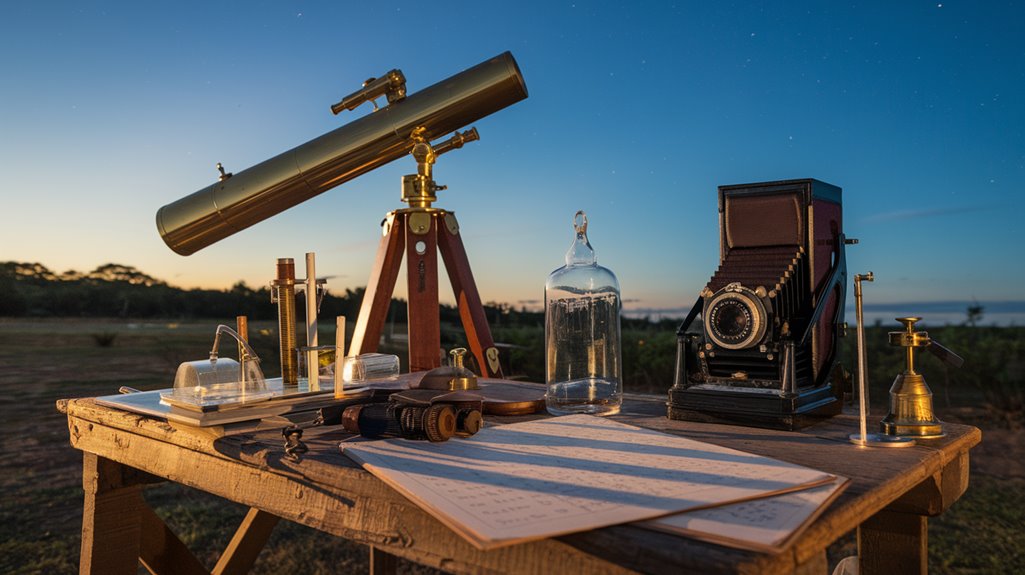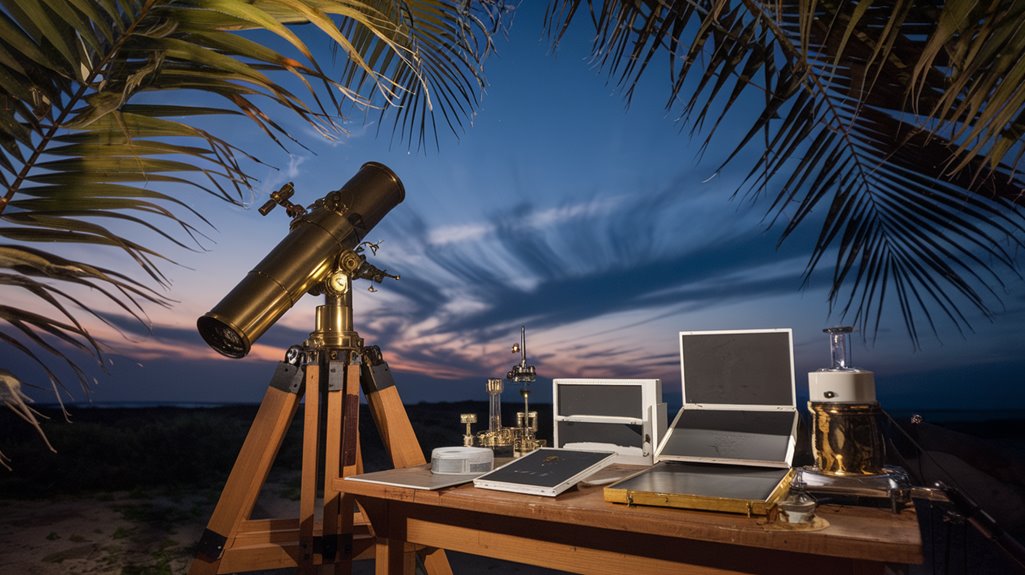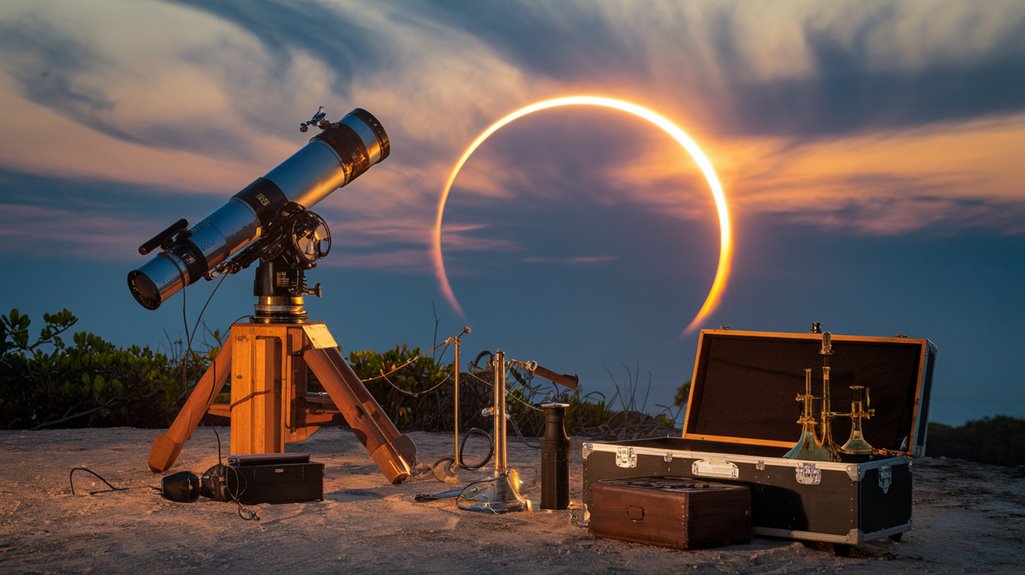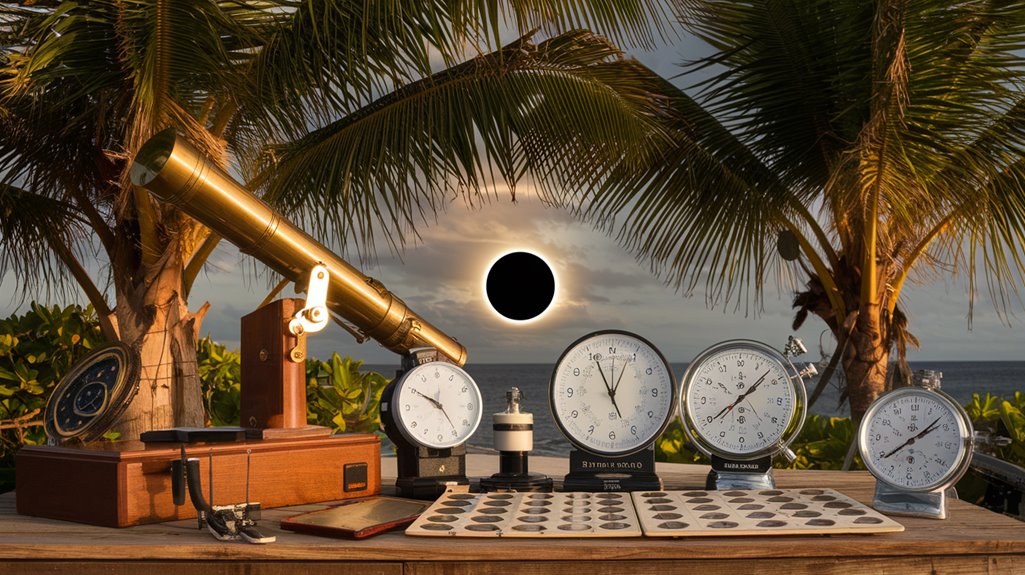A Solar Eclipse Confirmed Einstein’s Theory of Relativity
Light's gentle dance with gravity holds one of science's greatest revelations. You've likely heard of Einstein's theory of relativity, but you might not know that a simple shadow proved its brilliance. When the Moon blocked the Sun in 1919, it didn't just create darkness—it opened a window to verify what Einstein had boldly claimed: gravity bends light. Two teams of astronomers stood ready to capture this cosmic ballet, and what they discovered would forever change our view of the universe.
The Birth of Einstein's Revolutionary Theory

While many scientific breakthroughs happen suddenly, Einstein's theory of general relativity emerged through years of meticulous development. Between 1912 and 1915, you'd find Einstein wrestling with complex mathematical challenges as he refined his revolutionary ideas about gravity and spacetime.
Einstein's inspirations came from several sources, including his famous "happiest thought" about free fall and Galileo's observation that all objects fall at the same rate. During this formative period, he developed the equivalence principle that established free fall as inertial motion. His work proposed that space and time are unified into one entity, fundamentally changing our understanding of the universe.
He worked tirelessly with mathematicians like Marcel Grossmann, who introduced essential tensor analysis, and Tullio Levi-Civita, who guided him toward general covariance. Through thought experiments and mathematical struggles, Einstein gradually shaped his theory, incorporating Riemannian geometry and correcting his equations to account for energy conservation.
Despite setbacks and wartime disruptions, his persistence led to the groundbreaking 1915 publication.
Setting the Stage: The 1919 Solar Eclipse
After years of theoretical work, Einstein's groundbreaking ideas needed concrete proof – and the 1919 solar eclipse provided the ideal opportunity.
The historical context was essential, as World War I had previously prevented scientists from testing the theory. This eclipse's significance lay in its perfect timing and conditions. Led by Eddington and Dyson, the expedition would finally put Einstein's calculations to the test. The team conducted their observations from the Island of Príncipe, positioning themselves for optimal viewing conditions.
The eclipse offered scientists these key advantages:
- A total solar eclipse lasting 5 minutes for detailed observations
- Two prime viewing locations: Principe and Sobral
- Clear visibility of stars around the Sun during totality
- Just 19 hours after perigee, maximizing gravitational effects
You'll understand why this event was so essential when you consider that it allowed astronomers to photograph star positions using glass plates, comparing their apparent locations with and without the Sun's gravitational influence.
Two Teams, One Groundbreaking Mission
The ambitious scale of testing Einstein's theory required two separate teams working in different locations across the globe.
While team collaboration was essential, there wasn't any scientific rivalry between the groups – just a shared mission to prove or disprove Einstein's revolutionary ideas.
You'll find Eddington's team positioned on Príncipe Island off Africa's west coast, while Davidson's crew set up in Sobral, Brazil.
The teams used coelostats with mirrors to direct sunlight into their telescopes for precise measurements.
The teams worked under difficult tropical conditions while setting up their equipment and conducting observations.
Both teams faced the challenging task of photographing stars near the Sun during a total solar eclipse, comparing these images with nighttime star positions.
They'd use specialized telescopes and cameras to capture the brief moments when the Moon blocked the Sun's light.
Their efforts paid off magnificently – the observations showed stars shifted by 1.7 arc seconds, exactly as Einstein predicted, confirming that gravity does bend light.
Capturing Light Through the Darkness
During total solar eclipses, nature provides astronomers a rare window into Einstein's universe. When the Moon blocks the Sun's intense light, scientists can make critical celestial observations that are impossible during normal daylight hours. The eclipse creates a unique silvery gray atmosphere as colors dramatically fade. As the eclipse progresses, ambient temperatures drop in a measurable way.
To understand how astronomers captured evidence of light distortion near the Sun, consider these key steps:
- Photographers take precise images of stars visible during totality.
- They compare these images with photographs of the same stars taken at night.
- The difference in star positions reveals how much the Sun's gravity bends light.
- Measurements are analyzed to confirm Einstein's predicted 1.75 arc-second deflection.
This meticulous process during eclipse darkness allows scientists to witness Einstein's theory in action, as starlight curves around our Sun's massive gravitational field—a phenomenon that revolutionized our understanding of space and time.
The Day Science Changed Forever

On May 29, 1919, scientists witnessed a remarkable solar eclipse that would validate Einstein's revolutionary theory and forever change our understanding of the universe.
Einstein's theory faced significant resistance at first since Newton's mechanics dominated scientific thinking for over two centuries.
You might wonder how this cosmic phenomena led to one of history's greatest scientific breakthroughs. Despite challenging weather conditions, two expeditions, led by Sir Arthur Eddington in Príncipe and another team in Sobral, Brazil, captured essential photographic evidence of starlight bending around the sun.
Their findings confirmed Einstein's predictions about gravity's effect on light, proving his General Theory of Relativity. When Frank Dyson presented these results on November 6, 1919, the scientific community had to accept a new reality: Newton's laws weren't the complete picture.
Space, time, and gravity were far more complex than anyone had imagined.
Legacy of the Eclipse Experiment
Through its groundbreaking confirmation of Einstein's predictions, the 1919 solar eclipse experiment left an indelible mark on science that extends far beyond its era.
The scientific implications transformed our understanding of the universe, while public perception of theoretical physics changed dramatically. The expeditions led by Eddington and Crommelin provided the first empirical evidence needed to validate the theory.
You can trace the experiment's lasting legacy through these key impacts:
- It established general relativity as the cornerstone of modern physics, replacing Newton's theory of gravity.
- You'll find its principles at work in everyday technology, like your GPS navigation systems.
- It laid the foundation for understanding extreme cosmic phenomena, including black holes.
- It elevated Einstein to scientific superstardom, making complex physics accessible to the public.
This pivotal moment continues to influence how you understand space, time, and gravity today, while inspiring new generations of scientists to push theoretical boundaries.











